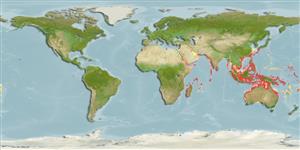Environment: milieu / climate zone / depth range / distribution range
Ecologia
marinhas; estuarina associadas(os) a recifes; intervalo de profundidade 0 - 20 m (Ref. 127989). Subtropical; 32°N - 33°S, 28°E - 178°W
Indo-West Pacific: Red Sea and East Africa to southern Japan, New Guinea and Arafura Sea (Ref. 9819). Reported from Vanuatu (Ref. 13300). Migrated to the Mediterranean from the Red Sea via the Suez Canal (Ref. 5385).
Tamanho / Peso / Idade
Maturity: Lm ? range ? - ? cm
Max length : 30.0 cm TL macho/indeterminado; (Ref. 30573)
Espinhos dorsais (total) : 12 - 13; Raios dorsais moles (total) : 8 - 11; Espinhos anais: 3; Raios anais moles: 9 - 11. Generally silver in color, with 4-6 dark horizontal lines; a black blotch behind head and below dorsal origin and another in front of dorsal fin may be present; caudal fin pale or slightly dusky (Ref. 4327).
Are coastal species often found in brackish waters; common in estuaries. They croak when taken from the water. Usually forming schools. Juveniles in seagrass beds and in mangrove bays (Ref. 48635). Feed on small fishes and invertebrates. Eggs are guarded and fanned by the male parent (Ref. 205). Maximum depth reported taken from Ref. 127989.
Life cycle and mating behavior
Maturidade | Reprodução | Desova | Ovos | Fecundidade | Larvas
Eggs are guarded and fanned by the male parent (Ref. 205).
Paxton, J.R., D.F. Hoese, G.R. Allen and J.E. Hanley, 1989. Pisces. Petromyzontidae to Carangidae. Zoological Catalogue of Australia, Vol. 7. Australian Government Publishing Service, Canberra, 665 p. (Ref. 7300)
Categoria na Lista Vermelha da IUCN (Ref. 130435: Version 2024-2)
Ameaça para o homem
Harmless
Utilização humana
Pescarias: pouco comercial
Ferramentas
Relatórios especiais
Descarregue XML
Fontes da internet
Estimates based on models
Preferred temperature (Ref.
123201): 24.4 - 29, mean 28 °C (based on 1262 cells).
Phylogenetic diversity index (Ref.
82804): PD
50 = 0.6250 [Uniqueness, from 0.5 = low to 2.0 = high].
Bayesian length-weight: a=0.01047 (0.00661 - 0.01659), b=3.02 (2.88 - 3.16), in cm total length, based on LWR estimates for this species & (Sub)family-body (Ref.
93245).
Nível Trófico (Ref.
69278): 3.6 ±0.4 se; based on diet studies.
Resiliência (Ref.
120179): Médio, tempo mínimo de duplicação da população 1,4 - 4,4 anos (Preliminary K or Fecundity.).
Fishing Vulnerability (Ref.
59153): Low vulnerability (20 of 100).
Climate Vulnerability (Ref.
125649): Moderate to high vulnerability (50 of 100).
Nutrients (Ref.
124155): Calcium = 34.7 [16.7, 81.9] mg/100g; Iron = 0.604 [0.350, 0.984] mg/100g; Protein = 20.1 [19.1, 21.1] %; Omega3 = 0.256 [0.154, 0.426] g/100g; Selenium = 14.2 [6.9, 26.8] μg/100g; VitaminA = 50.8 [15.9, 162.8] μg/100g; Zinc = 0.954 [0.631, 1.405] mg/100g (wet weight);
